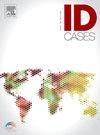Skull bone lytic lesions: A rare form of multifocal skeletal tuberculosis
IF 1
Q4 INFECTIOUS DISEASES
引用次数: 0
Abstract
Tuberculosis (TB) is a complex disease that can mimic numerous diseases involving different organ systems, making diagnosing TB challenging. Multifocal tubercular osteomyelitis is a rare form of skeletal TB that represents only a minority of all skeletal TB cases. Our patient, a 24-year-old immunocompetent male, complained of a low-grade fever that rises in the evening, scalp aches, right-sided chest pain, and non-inflammatory back pain with rest pain for six months. He had lost six kilograms over this period of illness. He was anemic, with mildly tender swelling in the right parietal region of the scalp. Diffuse tenderness was present over the dorsal spine and right side of the chest, with no evidence of gibbus. Multifocal skeletal tuberculosis was diagnosed based on the presence of lytic lesions in the skull, ribs, and vertebrae, along with high erythrocyte sedimentation rate and high tracer uptake on a bone scan, with a biopsy report showing a granulomatous lesion from the vertebra. After six months of anti-TB therapy, during a scheduled follow-up visit, the patient showed significant improvement in pain and general well-being, with an improvement of the skull lytic lesion on the x-ray. Multifocal tubercular osteomyelitis is rare in immunocompetent males without pulmonary involvement. Early recognition and subsequent treatment could prevent severe complications from bone destruction in these cases.
颅骨溶解性病变:一种罕见的多灶性骨结核
结核病是一种复杂的疾病,它可以模拟涉及不同器官系统的许多疾病,这使得结核病的诊断具有挑战性。多灶性结核性骨髓炎是一种罕见的骨骼结核,仅占所有骨骼结核病例的少数。我们的病人,24岁,免疫功能正常的男性,主诉有低烧,晚上发高烧,头皮疼痛,右侧胸痛,非炎症性背部疼痛伴休息痛6个月。他在生病期间瘦了六公斤。他贫血,右顶叶有轻度压痛性肿胀。弥漫性压痛出现在脊柱背侧和胸部右侧,没有证据表明有gibbus。多灶性骨结核的诊断基于颅骨、肋骨和椎骨溶性病变的存在,伴随着高红细胞沉降率和骨扫描高示踪剂摄取,活检报告显示椎骨肉芽肿性病变。经过六个月的抗结核治疗,在预定的随访期间,患者在疼痛和总体健康方面表现出显着改善,x光片上的颅骨溶解病变也有所改善。多灶性结核性骨髓炎在没有肺部受累的免疫功能正常的男性中是罕见的。在这些病例中,早期识别和后续治疗可以防止严重的骨破坏并发症。
本文章由计算机程序翻译,如有差异,请以英文原文为准。
求助全文
约1分钟内获得全文
求助全文

 求助内容:
求助内容: 应助结果提醒方式:
应助结果提醒方式:


